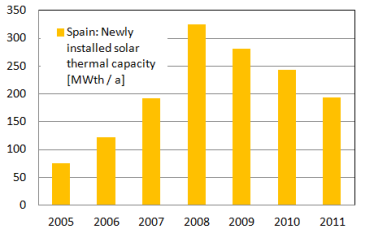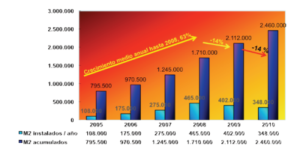Spain: Waiting on Renewable Energy Plan
July 9, 2012
Newly installed solar thermal capacity in Spain
 193 MWth or 275,590 m2: that’s how much Spain’s solar collector output and area grew last year, according to a market survey by the Solar Thermal Industry Association ASIT. It is a minus of 21 % compared to 2010 and the steepest decline the Spanish market has experienced so far. Now, the industry looks to the planned support tariff ICAREN for help. ICAREN is part of the country’s Renewable Energy Plan (PER). Although the PER was approved in November 2011, there has not yet been any action taken to actually introduce this tariff.
193 MWth or 275,590 m2: that’s how much Spain’s solar collector output and area grew last year, according to a market survey by the Solar Thermal Industry Association ASIT. It is a minus of 21 % compared to 2010 and the steepest decline the Spanish market has experienced so far. Now, the industry looks to the planned support tariff ICAREN for help. ICAREN is part of the country’s Renewable Energy Plan (PER). Although the PER was approved in November 2011, there has not yet been any action taken to actually introduce this tariff.
Source: ASIT
As ASIT writes in its market report (see the attached document), the Spanish solar thermal market still relies greatly on installations in new buildings (84%), which are constructed according to the Technical Building Code (CTE). Another 14 % were set up with the help of support programmes from the Autonomous Communities and the few remaining systems are pool absorbers. Despite growing costs for fossil fuels, the market for non-subsidised or legally mandatory glazed solar collectors is virtually non-existent.
Last year’s renewed drop in construction activities across Spain has also brought down the installation figures of solar thermal systems required in new buildings. According to ASIT’s data, Spanish companies were able to somewhat compensate for the decline in inland sales by shipping their systems abroad. The association estimates that around 88,000 m² of collector area were exported in 2011, based on the figures from nine major manufacturers. In 2010, the number was at 15,000 (based on eight companies) and before that, export figures were negligible. Today’s export seems even more relevant if one takes into account that Spanish companies only cover 44 % (121,000 m²) of the domestic market volume. The biggest importers come from Germany (26 %), Israel and Turkey (both together 16 %) Austria (5 %), as well as Italy and Greece (6 % combined) – as shown in the following chart.

Broken down by collector types, flat plate collectors make up 70 % of the market, followed by prefabricated solar hot water systems (glazed, but not clear whether flat plate or vacuum tube collector, 21%), vacuum tubes (6%) and pool absorbers (3 %).
Despite the difficult situation, solar thermal companies have not yet given up all hope. The PER includes an incentive mechanism called ICAREN, which is scheduled to start this year and aims to stimulate the sector for large-scale installations. Within ICAREN, Energy Service Companies (ESCOs) will receive an incentive for every kWh of renewable heat which they sell to their customers. The incentives will be paid out of a total budget of EUR 190 million, of which EUR 109 million are reserved for solar heat. According to the Renewable Energy Plan, ICAREN is expected to help with the installation of 50,000 m² in 2012, 100,000 m² in 2013, etc. – up to 500,000 m² in 2020.
The good intentions, however, seem to be just that: intentions. As time passes, a favourable outcome seems less and less likely. “Today, we do no longer know what to hope for. Do we even have a Renewable Energy Plan? And if so, is it the one that was decided last November, or will it be revised again? If it is revised, then what criteria will be important?” Pascual Polo, Secretary General of ASIT, asks.
“In our time, the emphasis is on promoting renewable energies. We will need to develop new strategies – such as new products, new foreign markets and alliances with other sectors – to strengthen the solar thermal sector and provide a better basis for negotiation, once the economic situation is stabilising,” Polo adds.
About ICAREN: http://www.solarthermalworld.org/node/2838
About ASIT (Spanish only): http://www.asit-solar.com


